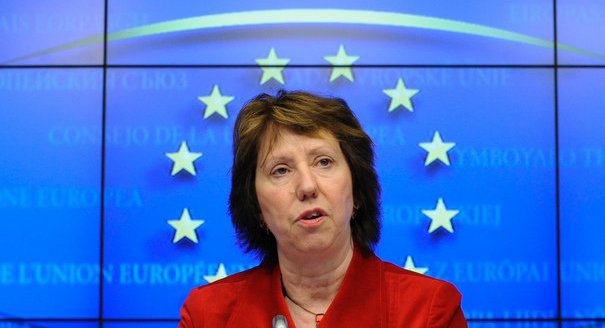Is the European External Action Service (EEAS) slowly finding its bearings? For a very long time, shaking your head in disbelief at the dysfunctional nature of the EU's diplomatic service was de rigeur among observers and analysts in Brussels and other European capitals. For sure, many of the structural weaknesses built into the service—as analyzed, for example, by Carnegie's Stefan Lehne—continue to hamper its performance. And the atmosphere inside the EEAS still seems to leave ample room for improvement. These problems will certainly not go away until some very fundamental repair-work is done. But a year and a half after after it started operations, some developments in the EEAS seem to indicate that, among the slowly settling dust, a number of good things are actually getting done.
Take Iran. When, after the last round of sanctions, Tehran agreed to enter new negotiations over its nuclear program, EEAS chief Catherine Ashton was tasked with leading the Western effort to keep the door open and interrupt the escalation towards war. Initially, many observers believed that Ashton was supposed to be just a stand-in for the Americans, who, in the midst of their election campaign, could not operate at full throttle. But now Ashton is getting good notes—and even some good press—on the performance of her team. This is no small achievement given the enormous international focus on this topic, the small trust base between the West and Iran, and the diplomatic requirements of keeping an international sanctions regime intact while navigating positions among participating parties.
Admittedly, the issue is far from being resolved. The unfolding situation in Syria, in which Iran is a key stakeholder, looms large over an extremely volatile region. And no one knows whether the continuing negotiations aren't just buying Iran time to advance its nuclear ambitions. But the door has not been slammed shut, and the EEAS, led by High Representative Ashton has been a key player in it. Who would have thought a year ago?
If timing—sanctions in combination with a U.S. election—was crucial for the EEAS' success in the Iran case, it was similarly important for another, possibly more substantial development. While the EU is completely absorbed with its struggle for survival in the seemingly endless debt and banking crisis, the EEAS, under the radar, has turned itself into a key service provider for foreign ministries around Europe. The diplomatic services of smaller member states in particular, hampered by limited man power and increasingly affected by austerity-related budget cuts, rely on the information and analysis coming out of the EEAS to stay afloat. According to one high-ranking diplomat from a smaller EU member state: "Our entire Middle East directorate consists of five people. That's not a unit, that's a directorate! Given the Arab Spring, Iran, Syria and Israel-Palestine, we would not be able to operate without the input coming from the EEAS in Brussels." The larger foreign ministries in countries such as France, Germany, and the UK might be able to run operations parallel to the EEAS. Other services can't, and for many, the situation is likely to get worse, not better, as the crisis continues to put stress on public coffers. It now seems that the crisis could turn into a blessing for the EEAS.
Combine these two developments with the continuing consolidation of some aspects of the service's inner workings—including the re-shuffle of some senior personnel—and increased outreach from the EEAS' leadership—unthinkable only a few months ago—and a slowly improving picture begins to emerge. The argument that time and patience are of the essence for a structure as new and complicated as the EEAS, made by many observers who believed the popular "Ashton bashing" to be rather premature and unfair, sounds more plausible now than a few months ago, when most people thought that all was lost. Doubts remain, of course, and not all is good in the EU's diplomatic apparatus. But certainly not all is bad either. Compare that to this time last year, and it looks like the EEAS has covered some significant ground.



.png)

.png)
